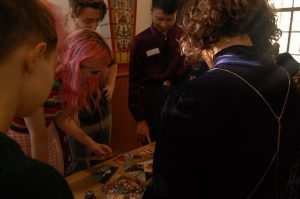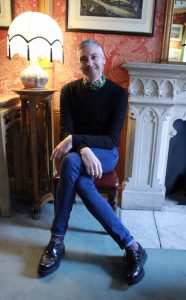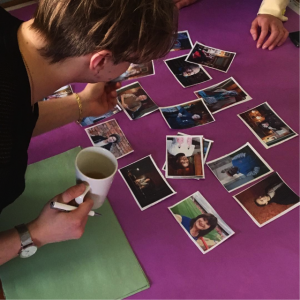Check out this blog post that Ellie, a member of our Queer Looks Young Project team, has written for the University of Brighton’s History of Art and Design blog…
Second year Fashion and Dress History student Eleanor Medhurst discusses her work with Brighton Museum’s Queer Looks Project
‘I found out about Queer Looks by a sponsored post on Facebook, which is a strange way to encounter something that has had such a positive impact on my life. As a Fashion and Dress History student, and as someone in the LGBT+ community, I was instantly drawn to the project. Queer Looks at Brighton Museum is a display opening this summer featuring outfits and stories from members of the LGBT+ community in Brighton and Sussex. I’ve been part of the Young Project Team, meaning that I have helped to reach out to members of the community, conduct oral history interviews with them, and consider which outfits might be best to put on display. Dress is, in my eyes at least, the most personalised aspect of design history. Through looking at dress we can read individual histories; the stories that we can discover through the outfits of Queer Looks tell us of the struggles facing individual people within the LGBT+ community, the struggles of the community as a whole, and – as I think it is most important to look at the positives – the pride, creativity, and resistance that can be expressed through clothing.
There’s been something so validating about creating this space for queer history and queer fashion to exist within the Museum. It’s been even more important that it’s been through the lens of our team, a group of young queer people, and through direct oral history interviews where members of the community have told their story, on their own terms. Often when queer history is told it is as a side note. This project, however, celebrates queer fashion not as fashion that happens to be worn or designed by a queer person, but as fashion and style that exists in its queerness. I exist as a hyper-feminine gay woman and that is told through my clothing. Jason, an interviewee, owned his pink velvet hotpants-and-waistcoat set specifically to wear to gay clubs in the ‘90s. The stories that our clothes tell are intrinsically linked with our identities and our place as members of the LGBT+ community reacting to a heteronormative society. They are a vitally important part of fashion and design history as a mass reaction to its heterosexual canon.
Deciding which stories to tell in Queer Looks has been a difficult issue. The display will only be able to hold around 20 outfits, but of course there are far more than 20 unique looks and stories that want to be seen and heard. The key was to think as inclusively as possible – a true history and representation of queer people’s looks would not be possible without a varied representation.
Many people perceive fashion and the LGBT+ community to be something that is flamboyant, or fabulous. Whilst this is often true, we are also a community of real people living real lives and it was important to present a history that is tangible, as queer fashion is something that exists all around us. We have tried our utmost to interview people with amazing style, but who also are a true reflection of the LGBT+ community. Amazing clothes are not all that is worthy of being kept in museums – they also need an accurate representation of the diversity of the people who the clothes belonged to.
Queer Looks is opening this summer, along with an additional microsite (to exhibit the outfits and stories unable to fit in the fashion gallery), but we’ll be putting on events celebrating queer fashion at the museum in the run-up to the opening of the display. One of these is on Saturday 3rd March for International Women’s Day. Keep an eye on the Brighton Museum Blog and the Instagram if you want to stay up to date.’



